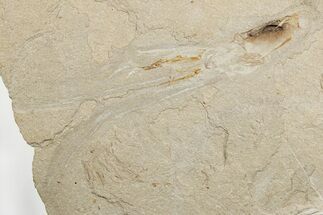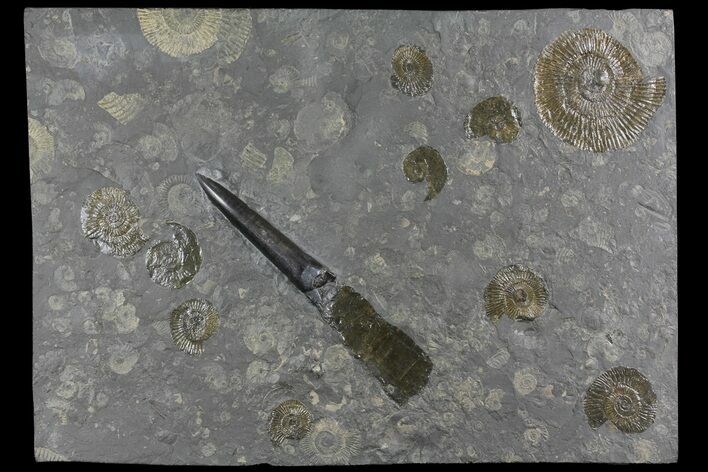This Specimen has been sold.
14" Fossil Belemnite and Ammonite Plate - Germany
This is a 14" wide shale plate that contains a fossil belemnite (Acrocoelites sp.?) rostrum and several ammonites (mostly Dactylioceras sp.) from the Posidonia Shale of Holzmaden, Germany. The rostrum of this belemnite has been polished and is still partially inflated. The pro-ostracum of the belemnite preserved nicely and has been coated in a sealant to bring out the detail. The pro-ostracum was an additional support feature for the soft body portions of belemnites and is rarely found preserved. The rostrum of this belemnite measures 3.5" long.
Comes with an acrylic/metal (gibson) display stand.
Comes with an acrylic/metal (gibson) display stand.
Belemnites are probably the most well known extinct cephalopod after the ammonites. They lived during the Jurassic and Cretaceous periods and are fairly common fossils found throughout the world. They had a hard, internal, cone-shaped structure that is often preserved as a fossil, though it is not technically a shell. They had ten arms but, unlike modern squid, these arms had small hooks instead of suckers.
About Ammonites
Ammonites were ancient marine cephalopods, similar to today's squids and octopuses, but with a defining feature: their distinctive, tightly coiled spiral shells. These shells, resembling those of modern nautiluses, served as both a protective home and a buoyancy aid, allowing ammonites to navigate the prehistoric seas with ease. First emerging around 240 million years ago in the Triassic Period, ammonites thrived for over 175 million years, adapting through numerous forms and sizes. As predatory creatures, they likely fed on smaller marine organisms, using their tentacles to capture prey. However, their long reign came to an end 65 million years ago at the close of the Cretaceous, coinciding with the mass extinction event that also eliminated the dinosaurs.
Ammonites were ancient marine cephalopods, similar to today's squids and octopuses, but with a defining feature: their distinctive, tightly coiled spiral shells. These shells, resembling those of modern nautiluses, served as both a protective home and a buoyancy aid, allowing ammonites to navigate the prehistoric seas with ease. First emerging around 240 million years ago in the Triassic Period, ammonites thrived for over 175 million years, adapting through numerous forms and sizes. As predatory creatures, they likely fed on smaller marine organisms, using their tentacles to capture prey. However, their long reign came to an end 65 million years ago at the close of the Cretaceous, coinciding with the mass extinction event that also eliminated the dinosaurs.
SPECIES
Acrocoelites sp? & Dactylioceras sp.
LOCATION
Holzmaden, Germany
FORMATION
Posidonia Shale
SIZE
6.8" Belemnite, 14 x 9.9" Rock
CATEGORY
SUB CATEGORY
ITEM
#167846
We guarantee the authenticity of all of our specimens.
 Reviews
Reviews















